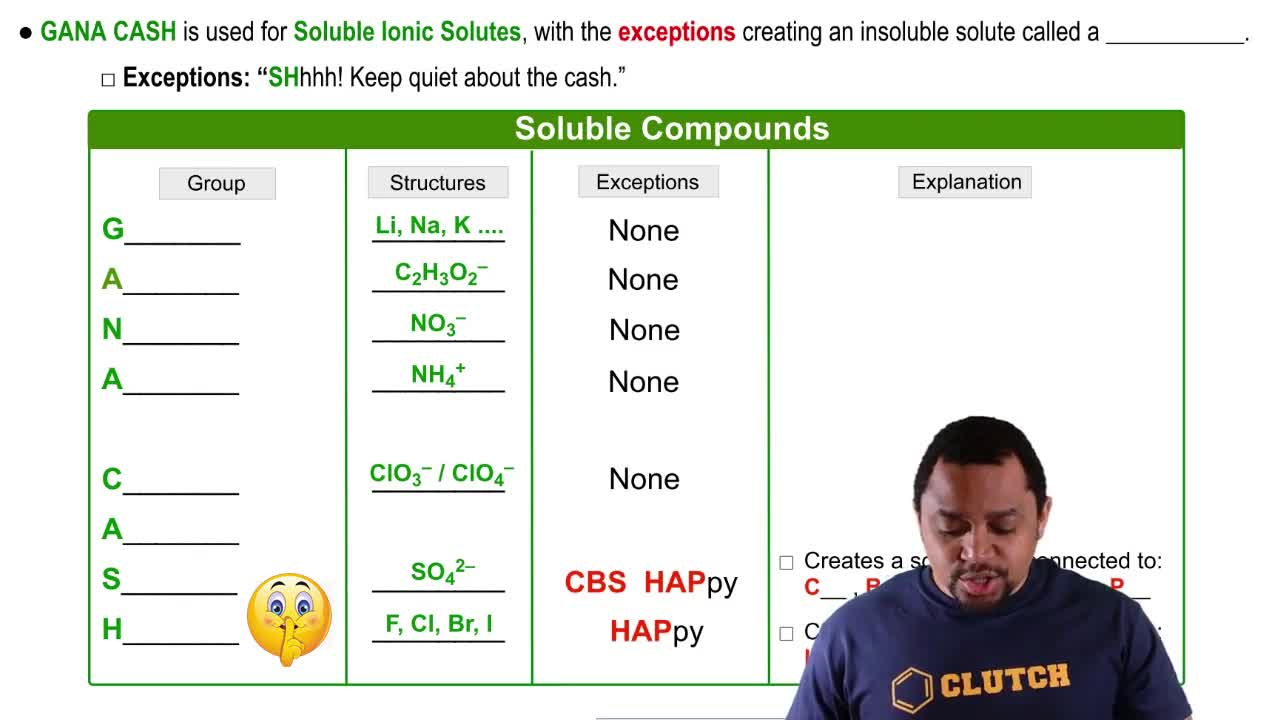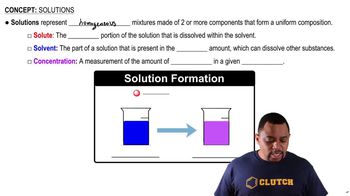Indicate the type of solute–solvent interaction (Section 11.2) that should be most important in each of the following solutions: (a) CCl4 in benzene
Ch.13 - Properties of Solutions

Brown14th EditionChemistry: The Central ScienceISBN: 9780134414232Not the one you use?Change textbook
Chapter 13, Problem 15c
Indicate the type of solute–solvent interaction (Section 11.2) that should be most important in each of the following solutions: (c) KBr in water
 Verified step by step guidance
Verified step by step guidance1
Step 1: Identify the solute and the solvent. In this case, KBr is the solute and water is the solvent.
Step 2: Determine the type of bonding in the solute. KBr is an ionic compound, which means it is made up of positive and negative ions.
Step 3: Determine the type of bonding in the solvent. Water is a polar molecule, which means it has a positive and a negative end.
Step 4: Based on the types of bonding in the solute and solvent, determine the type of solute-solvent interaction. In this case, the positive ions in KBr will be attracted to the negative ends of the water molecules, and the negative ions in KBr will be attracted to the positive ends of the water molecules.
Step 5: The type of solute-solvent interaction in this solution is ion-dipole interaction. This is because the ionic solute (KBr) interacts with the polar solvent (water) through attractions between the ions and the polar molecules.

Verified video answer for a similar problem:
This video solution was recommended by our tutors as helpful for the problem above.
Video duration:
1mWas this helpful?
Key Concepts
Here are the essential concepts you must grasp in order to answer the question correctly.
Ionic Compounds and Solubility
Ionic compounds, like KBr, consist of positively and negatively charged ions. When dissolved in water, these ions separate and interact with water molecules. The solubility of ionic compounds in water is largely determined by the strength of the interactions between the ions and the polar water molecules.
Recommended video:
Guided course

Soluble Ionic Solutes
Solute-Solvent Interactions
Solute-solvent interactions refer to the forces that occur between solute particles and solvent molecules. In the case of KBr in water, the primary interaction is ion-dipole forces, where the polar water molecules surround and stabilize the K+ and Br- ions, facilitating their dissolution.
Recommended video:
Guided course

Solution Components
Hydration Shell
A hydration shell is formed when water molecules surround and interact with dissolved ions. For KBr, the K+ ions attract the oxygen end of water molecules, while the Br- ions attract the hydrogen ends. This arrangement helps to keep the ions in solution and is crucial for understanding the solubility of ionic compounds in polar solvents like water.
Recommended video:
Guided course

Ionic Hydrates Naming
Related Practice
Textbook Question
Textbook Question
Indicate the type of solute–solvent interaction (Section 11.2) that should be most important in each of the following solutions: (b) methanol (CH3OH) in water
Textbook Question
Indicate the type of solute–solvent interaction (Section 11.2) that should be most important in each of the following solutions: (d) HCl in acetonitrile (CH3CN)
Textbook Question
Indicate the principal type of solute–solvent interaction in each of the following solutions and rank the solutions from weakest to strongest solute–solvent interaction: (a) KCl in water
Textbook Question
Indicate the principal type of solute–solvent interaction in each of the following solutions and rank the solutions from weakest to strongest solute–solvent interaction: (b) CH2Cl2 in benzene (C6H6)
